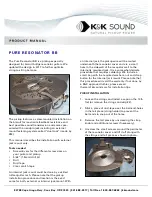
January 2006
2-14
Installation
Ensuring Heat Transfer
Be sure the sensor has an adequate heat sink when operating in hot
environments. The sensor must never be allowed to reach a
temperature above its rated limit. It is not sufficient merely to ensure
that the sensor is in an environment whose temperature is below the
rated limit; a means must be supplied to remove heat from the sensor.
When the Model 1111H or D-2 sensors are used at ambient
temperatures of 20° to 24°C, full rated depression can be achieved by
mounting the sensor on a smooth, thermally conductive surface (such
as metal), which tends to remain at the ambient temperature.
If possible, do not operate the sensor continuously at or near full
depression. Doing so may decrease the anticipated life of the
thermoelectric heat pump.
High Dew Point
Measurements
Using Heated Sensors
When measuring dew points at or above the ambient temperature, the
sensor must be heated to a temperature of at least 5 to 10°C above the
highest anticipated dew point (but not higher than the sensor
temperature rating). Some sensors can be mounted on a liquid heat
exchanger, or a temperature-controlled electric hot plate, or installed
in a heated enclosure. GE Infrastructure Sensing recommends closed-
loop active control of the elevated sensor body temperature.
The sensor base should be coated with zinc-oxide-filled silicone
thermal grease and securely anchored to the heat sink with suitable
fasteners. Allow ½ hour for the sensor to reach thermal equilibrium
after adjusting the temperature of the heat sink.
The GE Infrastructure Sensing SIM-12H high temperature sensor is
designed for high-temperature applications. It measures dew points
above ambient temperature without condensation problems.
Sample Lines for High Dew
Point Measurements
Sampling lines carrying gas to the sensor must be heated and
insulated when the dew point of the gas is above the sample line’s
ambient temperature. The simplest way to achieve this is to use heater
tape (either thermostatically controlled, or continuously operating,
and sized to provide the required temperature rise). At high
temperatures, use stainless steel tubing with adequate insulation to
avoid hot and cold sections in the line and to avoid water absorption/
desorption cycling as the heater is thermostatically controlled. Heated
sampling lines (HSL) are available from GE Infrastructure Sensing.
Summary of Contents for Optica
Page 1: ...GE Sensing Optica General Eastern Dew Point Analyzer Operator s Manual ...
Page 11: ...Chapter 1 ...
Page 20: ...Chapter 2 ...
Page 43: ...Chapter 3 ...
Page 58: ...Chapter 4 ...
Page 80: ...Chapter 5 ...
Page 94: ...Chapter 6 ...
Page 95: ...Network Based Programming Introduction 6 1 Programming Screens 6 1 ...
Page 99: ...Chapter 7 ...
Page 109: ...Appendix A ...
Page 114: ...Appendix B ...
Page 115: ...Humidity Equations and Conversion Chart Introduction B 1 Vapor Pressure B 1 Humidity B 2 ...
Page 119: ...Appendix C ...
Page 120: ...Configuring the Serial Interface Wiring to a Personal Computer C 1 ...
Page 122: ...Appendix D ...
Page 127: ...Appendix E ...
Page 128: ...Glossary ...
Page 130: ...Appendix F ...
Page 133: ...Appendix G ...
















































